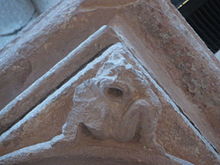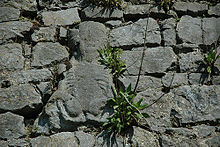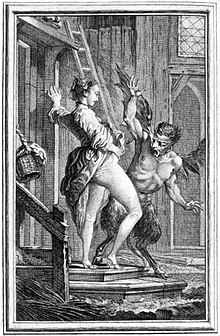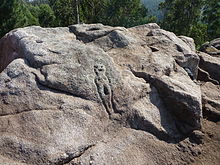
In Gaelic myth, the Cailleach is a divine hag and ancestor, associated with the creation of the landscape and with the weather, especially storms and winter. The word literally means 'old woman, hag', and is found with this meaning in modern Irish and Scottish Gaelic, and has been applied to numerous mythological and folkloric figures in Ireland, Scotland, and the Isle of Man. In modern Irish folklore studies, she is sometimes known as The Hag of Beara, while in Scotland she is known as Beira, Queen of Winter.
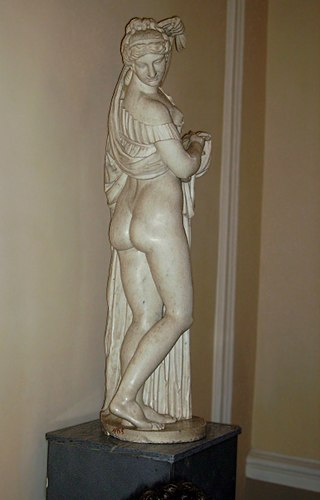
Anasyrma composed of ἀνά ana "up, against, back", and σύρμα syrma "a dragging motion"; plural: anasyrmata (ἀνασύρματα), also called anasyrmos (ἀνασυρμός), is the gesture of lifting the skirt or kilt. It is used in connection with certain religious rituals, eroticism, and lewd jokes. The term is used in describing corresponding works of art.

A hunky punk is a grotesque carving on the side of a building, especially Late Gothic churches. Such features are especially numerous in Somerset.

Shanballymore is a small village in County Cork, Ireland. It neighbours the towns of Doneraile, Kildorrery and Castletownroche, and is off the main route from Mallow to Mitchelstown. Shanballymore is part of the Cork East Dáil constituency.

Braunston-in-Rutland is a village and civil parish in the county of Rutland in the East Midlands of England. The population of the civil parish was 392 at the 2001 census, including Brooke and increasing to 502 at the 2011 census. Leicestershire lies on the parish's western boundary

Apotropaic magic or protective magic is a type of magic intended to turn away harm or evil influences, as in deflecting misfortune or averting the evil eye. Apotropaic observances may also be practiced out of superstition or out of tradition, as in good luck charms, amulets, or gestures such as crossed fingers or knocking on wood. Many different objects and charms were used for protection throughout history.

Boa Island is an island near the north shore of Lower Lough Erne in County Fermanagh, Northern Ireland. It is 16 mi (26 km) from Enniskillen town.

White Island is an island in Lower Lough Erne, County Fermanagh, Northern Ireland. It is situated in Castle Archdale Bay off the east shore of Lower Lough Erne. The ruins of an ancient church are found near the shore, built on the site of an earlier monastic settlement. It still has an intact arched Romanesque doorway. The Church and carved figures are State Care Historic Monuments sited in the townland of White Island, in Fermanagh and Omagh District Council area, at grid ref: H1753 6000. The rath, earthwork, and area surrounding the state care monument are Scheduled Historic Monuments, at grid ref: H1753 6000. The island is accessed by ferry from the marina in Castle Archdale Country Park, near Irvinestown. Location: OpenStreetMap Reference

Ballinacarriga Castle is a 16th-century tower house located in the village of Ballinacarriga, about 9 kilometres (5.6 mi) from the town of Dunmanway and 7.5 kilometres (4.7 mi) from the village of Ballineen. There is also a school nearby.

Dilukai are wooden figures of young women carved over the doorways of chiefs' houses (bai) in the Palauan archipelago. They are typically shown with legs splayed, revealing a large, black, triangular pubic area with the hands resting on the thighs. These female figures protect the villagers' health and crops and ward off evil spirits. They were traditionally carved by ritual specialists according to strict rules, which, if broken, would result in the deaths of the carver and the chief. Female figures presenting their vulva can be found in many cultures: they symbolize fertility, (spiritual) rebirth, and they protect from evil.

A hag is a wizened old woman, or a kind of fairy or goddess having the appearance of such a woman, often found in folklore and children's tales such as "Hansel and Gretel". Hags are often seen as malevolent, but may also be one of the chosen forms of shapeshifting deities, such as The Morrígan or Badb, who are seen as neither wholly benevolent nor malevolent.

"Sheela-Na-Gig" is a song by English alternative rock singer-songwriter PJ Harvey, written solely by Harvey. The song was released as the second single from her debut studio album, Dry, in February 1992. The single was the second, and final, single from Dry and only single from the album to enter the charts in both the United Kingdom and United States. An accompanying music video, directed by Maria Mochnacz, was released alongside the single.

The vagina and vulva have been depicted from prehistory onwards. Visual art forms representing the female genitals encompass two-dimensional and three-dimensional. As long ago as 35,000 years ago, people sculpted Venus figurines that exaggerated the abdomen, hips, breasts, thighs, or vulva.

Clomantagh Castle is a 15th-century tower house located near Freshford, County Kilkenny, in Ireland. Originally constructed in the 1430s, additional buildings and outbuildings were added in the subsequent centuries - including a connected 19th century farmhouse. Carvings on the castle's walls include a Sheela na gig relief.

Castlemagner is a village and townland in the Duhallow area of north-west County Cork, Ireland. Castlemagner is within the Cork North-West.

The Liathmore Sheela-na-gig is part of the northern doorway at the larger church ruin at Liathmore monastic site in the townland of Leigh, County Tipperary. Its Sites and Monuments Record no. is TN042-055004.
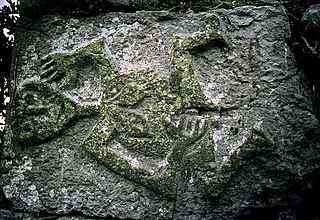
The Kiltinan Church sheela-na-gig is a carved depiction of a nude woman exposing her vulva which used to be part of Kiltinan Church ruin near Fethard, County Tipperary as a quoin stone in the Southwestern corner of the church. However, it was stolen in 1990 and has not been located since. Fethard Historical Society issued a Wanted poster to help with the retrieval. The National Sites and Monuments no. is TS070-101003.

The Fethard Abbey Sheela-na-gig is located in a wall on the grounds of the former Augustinian Abbey in Fethard. Its National Sites and Monuments number is TS070-040030. One of its earliest mentions is in the School Collection which also includes a black and white photograph.

The Green Man is a term with a variety of connotations in folklore and related fields.
Project Sheela is an Irish contemporary street art initiative that emerged on International Women's Day in 2020, capturing attention both online and offline. The project, spearheaded by two anonymous Dublin-based artists, celebrates themes of women's rights, female sexuality and empowerment, through the deployment of Sheela-na-gig sculptures across Dublin. The project returns each year for International Women's Day, focusing on sites significant to women's rights.


